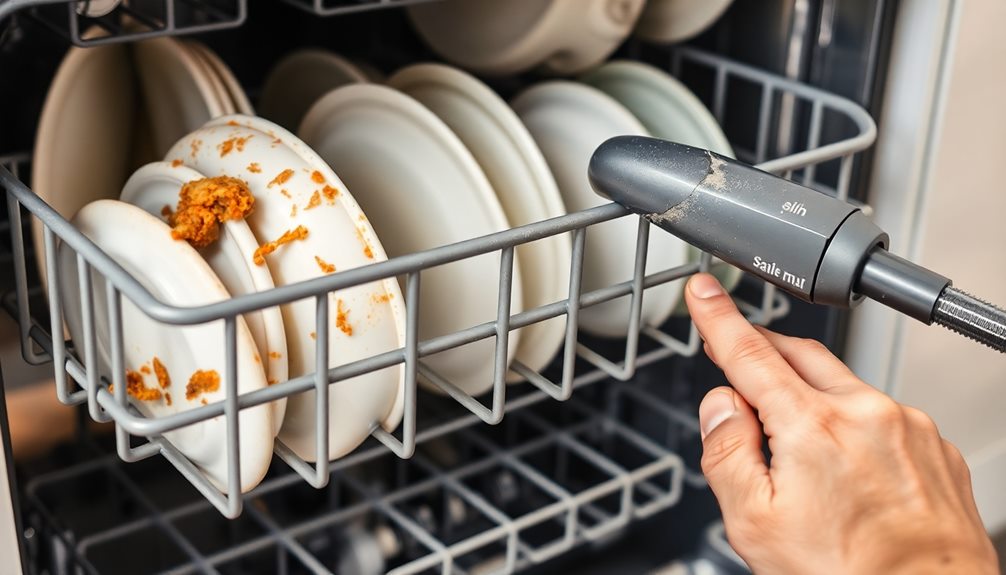If your dryer is taking multiple cycles to dry your clothes, check if you're overloading it. A full dryer restricts hot air circulation, leading to inefficient drying. Also, make sure to clean the lint filter before each use. A clogged filter can greatly hamper airflow and cause longer drying times. Inspect your dryer vents regularly, as blockages can trap damp air inside. Finally, verify your washing machine is extracting enough water during the spin cycle; if clothes are too wet, your dryer will struggle. There's more you can do to enhance your dryer's efficiency, so keep exploring!
Key Takeaways
- Ensure the dryer is not overloaded; aim for a load about two-thirds full for optimal airflow and drying efficiency.
- Clean the lint filter after every cycle to prevent airflow restrictions and improve drying performance.
- Check for blocked dryer vents; regular inspection and cleaning can significantly reduce drying times.
- Verify that your washer is effectively spinning clothes to extract sufficient moisture before drying.
- Match dryer settings to fabric types; using the correct heat and cycle options can enhance drying efficiency.
Overloading the Dryer

Overloading your dryer's capacity can seriously hinder its performance. When you stuff your dryer beyond its limits, you restrict hot air circulation, which leads to longer drying times and damp clothes.
Ideally, your dryer should be about two-thirds full to guarantee ideal airflow and drying efficiency. If you overload it, you may find yourself running multiple cycles to dry your laundry properly, greatly increasing your energy usage.
It's essential to follow the manufacturer's recommendations for load size. Ignoring these guidelines can cause excessive wear and tear on your dryer, leading to costly repairs down the line.
Bulky items, in particular, can trap moisture and hinder drying, so make sure to spread clothes evenly within the dryer. This way, each piece gets the hot air it needs to dry effectively.
Clogged Lint Filter

One of the most common reasons your dryer takes multiple cycles to dry clothes is a clogged lint filter. When the lint filter is full, it restricts airflow, which leads to longer drying times and can even cause overheating.
To keep your dryer running efficiently, make certain to clean the lint screen after every drying cycle. This simple task can greatly reduce drying times and improve overall performance.
Additionally, consider deep cleaning the lint filter every few months. Use warm, soapy water and a gentle scrub to remove any buildup that regular cleaning might miss.
This regular maintenance guarantees ideal airflow, reducing the risk of dryer repair down the line.
Stifled Airflow in Vents

Regularly checking your dryer's venting system is essential for ideal performance. Blocked vents can trap hot, damp air, leading to longer drying cycles. Restricted airflow forces your dryer to work harder, wasting energy and time.
| Signs of Stifled Airflow | Recommended Actions |
|---|---|
| Extended drying cycles | Inspect vent for clogs |
| Overheating dryer | Clean with a vacuum |
| Excess lint buildup | Use a vent brush |
| Kinks in vent hose | Straighten or replace |
Cleaning your vents is critical. Lint buildup and debris can easily accumulate, greatly impacting airflow. If you notice your dryer taking multiple cycles to dry clothes, it's time to take action. Consider professional cleaning at least once a year to keep your system in top shape and prevent clogs.
Using basic tools to clean the vents is straightforward and can markedly enhance your dryer's performance. By ensuring unobstructed airflow, you'll not only improve drying times but also reduce the risk of potential fires. Prioritize vent maintenance for a more efficient and safe drying experience.
Malfunctioning Heating Element

If your dryer isn't heating properly, it might be time to look into a malfunctioning heating element. A defective heating element can create insufficient heat, leaving your clothes taking multiple cycles to dry completely.
When the heating element fails, it usually does so either completely or intermittently, drastically extending your drying times.
To determine if you're dealing with heating element failure, you can conduct regular testing with a multimeter. A lack of continuity during the test signifies a problem with the heating element.
If you find it's defective, it's vital to seek professional inspection and replacement. The complexity of the repair can be quite challenging, and it's often best left to experts.
Ensuring the heating element is in good condition is important for maintaining efficient dryer performance. A malfunctioning heating element is a common culprit behind poor drying results, so addressing this issue can save you time and energy in the long run.
Don't let a simple component keep your laundry routine from running smoothly; check your heating element today!
Thermostat Issues

If your dryer isn't heating properly, a malfunctioning thermostat might be the culprit.
You can test the thermostat's functionality with a multimeter to see if it's working as it should.
Regular checks can help prevent unexpected issues and keep your dryer running efficiently.
Thermostat Temperature Regulation
Over time, a malfunctioning thermostat can lead to significant issues with your dryer's performance. The thermostat plays an important role in temperature regulation, ensuring your dryer heats properly. When it malfunctions, it can cause either overheating or insufficient heating, which means your dryer takes too long to dry your clothes, often leading to multiple cycles for a single load.
Regular maintenance of your dryer, including checking for airflow issues and ensuring proper ventilation, is essential for peak performance, as these factors can impact drying efficiency. Additionally, understanding the importance of effective filtration can help you maintain a clean environment around your dryer, further enhancing its operation.
To maintain efficiency, regular maintenance of the thermostat is essential. Without it, your dryer may run longer than necessary, wasting energy and time. If you notice your dryer isn't performing as it should, the thermostat could be the culprit. You might need to test it using a multimeter to check its functionality and determine if it requires replacement.
If you find that the thermostat is defective, it's best to seek professional assistance. A trained technician can safely and correctly replace the thermostat, restoring your dryer's heating capabilities.
Testing Thermostat Functionality
Sometimes, a faulty thermostat can be the hidden culprit behind your dryer's extended drying times. This crucial component regulates the temperature during the heating cycle, and a malfunctioning thermostat can lead to inefficient drying or overheating.
To test its functionality, follow these steps:
- Turn off the power: Always disconnect your dryer from the power source before conducting any tests.
- Use a multimeter: Check for continuity across the thermostat terminals. If you don't find continuity, it indicates a faulty thermostat in need of replacement.
- Inspect for overheating: If the thermostat is malfunctioning, it may cause the dryer to run inefficiently, leading to even longer drying cycles.
Regular maintenance on your thermostat is essential to prevent unexpected performance issues.
If you suspect your thermostat is the problem, it's wise to seek professional assistance for an accurate diagnosis and replacement. Taking these steps can save you time and energy, ensuring your dryer operates efficiently.
Inefficient Washer Spin Cycle

If your dryer is taking multiple cycles to dry your clothes, it might be due to an inefficient washer spin cycle. When you don't set your washer to the highest spin speed, clothes can come out too wet, making it harder for the dryer to do its job.
Regularly checking and adjusting your washer settings can help guarantee your clothes are only slightly damp before they hit the dryer.
Additionally, understanding the importance of specific gym hours can help you manage your time effectively, allowing you to fit in laundry and workout sessions seamlessly.
Spin Cycle Analysis
An inefficient spin cycle in your washer can be a hidden culprit behind your dryer taking multiple cycles to dry clothes. If your clothes are coming out excessively wet, it's time to analyze your washer's spin cycle.
Here are three key areas to check:
- Spin Settings: Confirm your spin settings are correctly adjusted for the type of load you're washing. Using the right settings can provide adequate moisture extraction, just as selecting the best vacuums for dust removal guarantees efficient cleaning.
- Malfunctioning Washer: If your washer isn't extracting enough water, it might be malfunctioning. Look for signs of wear or failure and consider scheduling a service check to resolve any underlying issues.
- Regular Maintenance: Performing regular maintenance on your washer's spinning mechanism can prevent excessive moisture retention. Inspect the washer periodically to guarantee ideal operation.
A properly functioning spin cycle should only leave clothes slightly damp before transferring them to the dryer.
Addressing these issues can greatly improve your overall drying performance, reducing the number of cycles needed to get your laundry dry.
Adjusting Washer Settings
Adjusting your washer settings can make a significant difference in drying efficiency. If your spin cycle isn't extracting enough water, your clothes come out excessively wet, leading to longer drying times in the dryer.
To optimize your drying process, always choose the high spin option on your washer settings. This maximizes water extraction, ensuring your clothes are as dry as possible when they enter the dryer.
It's also essential to regularly check and maintain your washing machine. A malfunctioning spin cycle can leave your laundry damp, making it harder for the dryer to do its job efficiently.
Refer to your washer's user manual for specific settings that enhance spin performance based on the fabric type. For instance, delicate fabrics may require a gentler cycle, while heavier items benefit from a more robust spin.
Incorrect Dryer Settings

Many homeowners struggle with their dryers due to incorrect settings, leading to frustratingly long drying times.
If your clothes are taking multiple drying cycles to fully dry, it's time to rethink your approach. Here are three key factors to evaluate:
- Fabric Type: Always match your dryer settings to the fabric type. Heavy fabrics need higher heat settings, while delicate materials require gentler cycles. Using the wrong setting can greatly prolong drying time.
- Moisture Sensing: Make sure to use the moisture sensing option if your dryer has it. This feature adjusts drying time based on how wet your clothes are, enhancing drying efficiency.
- User Manuals: Don't underestimate the importance of user manuals. They provide specific recommendations for ideal dryer settings, ensuring you achieve adequate drying times for each load.
Incoming Power Problems

If you're still experiencing long drying times after checking your dryer settings, incoming power problems might be the culprit.
Electric dryers need a strong power source to function effectively, typically requiring a 240-volt outlet. If your dryer's plugged into a standard 120-volt outlet, you might find that your dryer takes forever to dry your clothes, possibly tripling the drying time.
An insufficient power supply can lead to extended drying cycles, so it's important to verify the outlet voltage before diving into other troubleshooting steps.
Additionally, avoid using an extension cord for your dryer connection. These cords can't safely support the electrical demands of your appliance, leading to performance issues and longer drying times.
Make sure your dryer is properly connected to the electrical system to confirm it's receiving the necessary voltage for peak operation.
If you suspect any issues with the power supply or if your dryer still isn't functioning properly despite being plugged into the right outlet, it might be time for consulting an electrician. They can help diagnose and resolve any underlying electrical problems, confirming your dryer operates effectively.
Maintenance Tips for Efficiency

Maintaining your dryer is vital for guaranteeing it operates efficiently and effectively. Regular maintenance can greatly improve drying performance and save you time and energy. Here are some key maintenance tips to follow:
- Clean the lint screen: Always clean the lint screen before each drying cycle. This guarantees ideal airflow and prevents extended drying times.
- Schedule vent cleaning: Make it a habit to schedule annual vent cleaning. This removes lint buildup and obstructions that can restrict airflow and pose fire hazards.
- Check washer settings: Verify your washer settings are correct. Adequate spin cycles are essential for effective water extraction; if clothes come out too wet, your dryer will struggle to dry them efficiently.
Additionally, inspect the blower wheel to confirm it rotates freely.
Testing the heating element and thermostat with a multimeter can help confirm they're functioning correctly. This prevents inefficient drying caused by malfunctioning components.
Frequently Asked Questions
How Do You Fix a Dryer That Takes Multiple Cycles to Dry?
To fix your dryer, check for an overloaded drum and clean the lint screen. Make certain your vent's clear, verify proper washer spin settings, and confirm it's receiving enough power to improve drying efficiency.
Why Does My Dryer Take Multiple Loads to Dry?
Did you know that up to 90% of dryer problems stem from poor airflow? Your dryer might take multiple loads to dry due to overloading, a clogged lint filter, or blocked vents restricting airflow.
How Do I Know if My Dryer Vent Is Clogged?
You'll know your dryer vent is clogged if your clothes take longer to dry, you notice a burning smell, or the dryer feels hot. Check for lint buildup by inspecting and cleaning the vent regularly.
How Do I Fix My Dryer Not Drying Fast?
To fix your dryer not drying fast, don't overload it, clean the lint filter regularly, check the vent for clogs, guarantee the power supply is adequate, and verify your washing machine's spin cycle works properly.
Conclusion
If your dryer's taking multiple cycles to dry, think of it like trying to run a race with a heavy backpack—it's just not going to work efficiently. By addressing issues like overloading, clogged lint filters, and airflow problems, you can boost your dryer's performance markedly. Don't forget to check the settings and verify everything's functioning properly. With a little maintenance, your dryer can work like a charm, saving you time and energy in the process!










